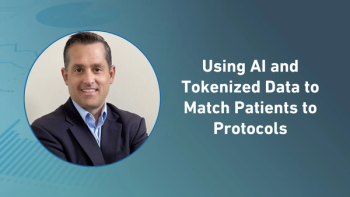
How Reverse-Engineering Clinical Trials to Leverage the AI-based-Digital Twin Solution Solves for Many Current Issues
These devices can help researchers identify data points that are not immediately available to researchers.
Digital solutions, such as wearable sensors, have become prevalent in many areas of clinical development, and organizations have introduced teams whose goals are to identify and operationalize these in ongoing or new trials. A further digital layer now being considered by many is the use of artificial intelligence (AI) that intends to leverage the power of complex algorithms to look more closely at insights that may not be immediately evident to researchers. Using AI algorithms to analyze data collected through wearable sensors can provide understandings into a patient's health status and treatment response–providing clinicians with the power to make smarter and faster decisions. The goal of using AI-driven digital endpoints is to improve the accuracy and precision of data analysis, along with identifying new biomarkers and endpoints that could be used to improve future trials. AI-driven digital endpoints can also be used to help identify patients who may be at high risk for certain conditions or to help personalize treatment plans based on individualized instead of generalized patient needs.
Why digital solutions and endpoints matter in clinical trials
A common question is if digital solutions and endpoints are relevant when so much research and development has been done without them to date. To answer, the comparison can be made to the adoption of similar disruptive technologies like the now commonly used electronic data capture (EDC) systems. Initially, EDC was not widely adopted and of course, it is still possible to run trials with paper case report forms, but given the EDC advantages, most will never look back to the old way.
Using advanced wearables and AI-based digital endpoints coupled with near real-time data collection capabilities can generate unique and relevant insights that effectively enable the ability to remotely monitor patients without requiring them to commute to a clinical site–giving patients, caregivers, and clinicians more flexibility.
For example, trials require patients to travel a significant distance for care and assessments. Face-to-face appointments take time, and depending on travel distance–or if their caregiver needs to take time away from other responsibilities like childcare or work–they can be especially burdensome. Providing patients the freedom to be treated and monitored without leaving the comfort of their homes opens the door to a more diverse patient population who may not have been able to receive treatment.
Additionally, the cost of face-to-face doctors’ visits, or even in-patient monitoring–for specific therapies that incur safety risks–can be prohibitively high, limiting the treatment to a relatively small subset of the patient population, excluding many who would otherwise benefit from the therapy.
Furthermore, these in-person visits, while valuable, don’t give clinicians the full picture of a patient’s progress or possible deterioration since they only capture patient data for a moment in time. By utilizing wearable sensors and digital endpoints, a cancer patient’s care team can continuously see, in near real-time, the patient’s physiology. In the case of cancer patients receiving new immunotherapies, which can bring a higher risk, real-time monitoring of their physiology can be lifesaving as it may help alert clinicians of any safety issues.
Overall, the use of remote patient monitoring in clinical trials makes the participation process easier, more convenient, cost-effective, safer, and more inclusive for patients.
Potential deployment challenges associated with digital health solutions
Many trial designs and execution fail to take into consideration how their designs could create undesired consequences like high improbability of effective translation from trial execution goals to real-world care needs, impose unintended barriers for patients to become part of the trial conduct phase, and potentially deliver results that are non-representative of the efficacy and/or safety of the therapies when they are used in a broader, real-world patient population.
Examples of these shortcomings include imposing baseline technology ownership/access needs that unintentionally exclude certain lower socio-economic class populations. Persons that don’t own a smartphone, for example, could be excluded from trial participation. Even if a smartphone is provided to the patient as a part of the study, their digital literacy level may not be sufficiently robust to successfully manage the study requirements. In some cases, using several vendor solutions in the same trial–like an elderly heart patient that needs to use a smart-wearable, enter electronic patient-reported outcomes (ePROs) data into a tablet, monitoring their medication and compliance level, while making sure that their devices are always properly charged and connected–creates a burdensome orchestration role for the patient, or in some cases their caregiver, who has to manage the multiple technology parts and pieces to obtain the trial-relevant data.
Many of the solutions have not lived up to either the expectations or the anticipated return on investments. Considerable efforts are now being made to revisit decisions and approaches used to determine the best steps forward given the previous gaps in patient diversity and inclusion. A better measure of success may depend on understanding how easily these solutions will be added to existing pathways. To do so requires a better understanding by those who oversee clinical trials acknowledging the changes needed to reach a more diverse patient population and how these solutions need to be used beyond the parameters of traditional clinical trials.
Not all digital solutions are created equally
Moving away from the one-size-fits-all model
The sophistication and capabilities of digital solutions (including the sensors and AI-based insights models) are growing, and for many experts, it has become evident that a combination of different endpoints leads to a clearer picture of a patient’s condition. For example, old standards of accelerometry (actigraphy) data models, to measure everything from heart failure to neurodegenerative disease, is enriched by leveraging physiology data in addition to accelerometry data for insight generation. So, in addition to activity, the heart failure patient will also be monitored for functional capacity using AI-based analytics that calculates eVO2max scores, whereas the Parkinson’s patient will simultaneously be accessed for heart rate and heart variability to better understand therapy risks.
From Retrospective to Real-Time
With the growing adoption of decentralized trial designs, continuous and near real-time availability of the digital solutions data from remote settings, like a patient’s home also becomes an important factor in the design and execution of clinical trials. When applied to AI-based analytics this continuous data informs both safety and efficacy endpoints in an unparalleled way.
From ‘Cooked’ to Raw
As many devices limit the availability of or modify the data analytics used to produce the output, the value of having the raw waveform to help build the current AI models also becomes a more critical differentiation. An example of the impact is seen in long-term programs with an early version of a wearable that did not provide raw data, and now are not able to leverage the historical endpoint data collected because analytics used by the wearable to calculate the endpoints changed over time–thus becoming similar but new endpoints with each revised analytic used by the wearable. By having raw data, the analytics could be rerun with all the endpoint relevant data, past and present, and thus allows for continuity over time of the endpoint results.
The Right Tool for the Right Job
Researchers also need to be aware of the potential for bias in AI algorithms and take steps to find the right solution to help minimize bias to ensure that their results are accurate and reliable. Even sensor selection can contribute to bias, as seen recently with the challenge to accurately measure oxygen saturation values with pulse oximeters when measuring patients with pigmented skin since these patients were under-represented in the testing and validation phases. The ideal way to circumvent biases induced by a comparison made with a non-representative patient population would be to compare one’s data to themselves, in a kind of before-and-after model.
AI data and clinical trial bias mitigated by using an AI-based digital twin
Bias in clinical trials can mean systematic errors that can occur in the design, conduct, or analysis of a study, which can lead to inaccurate or misleading results. Several types of bias can occur in clinical trials, but one with the greatest impact is the bias in the selection process.
Selection bias occurs when the participants in a study are not representative of the population of interest. For example, if a study only includes participants who are both able (economically, geographically, and technologically literate) and highly motivated to participate, the results may not be generalizable to the broader population. A further bias challenge is using endpoints developed on generalized population data, which may not apply well to populations that have traditionally not been included in the development of this data set. The earlier examples of inaccurate oxygen saturation measurements in persons with pigmented skin perfectly illustrate this point.
To remove bias, an AI model can be applied where each patient serves as their own control, akin to a before-and-after model. This can be achieved by applying an AI model on the patient’s own physiology data to create a representative digital twin. For example, a patient who will receive an oncology immunotherapy treatment will first be monitored for at least 48 hours before the commencement of the therapy. During this time, the patient’s physiological parameters (e.g., temperature, heart rate, respiratory rate, etc.) while engaging in activities of daily living are continuously measured. This data will be processed using an AI model to create a comprehensive representation of this individual’s unique physiology, from which all future collected data (including post-therapy), will be measured.
The digital twin approach allows for truly personalized patient insights as all comparison is based on the patient’s own expected results. Deviations from the modeled results reliably indicate when a relevant and persistent change (positive and/or negative) from the expected result has occurred. These changes can be leveraged for a better understanding of the performance of the therapy, and/or how to best care for this one specific patient. Given the sensitivity and specificity of this model, very subtle change can be seen, and in many cases even before any clinical symptoms present. By including this ‘early detection’ concept into the trial design, the digital twin change may trigger an appropriate intervention that can help change the course of care and possibly prevent or limit the onset of adverse events or reactions and support better risk/benefit profiles for the therapies.
Generalized population endpoints that drive study results also lead to situations where drugs and therapeutics that do end up making it to market may not be tailorable to a wide variety of people. The shortcomings created by the failure of inclusion and diversity become less relevant in a model that compares an individual to themselves.
Leveraging reverse-engineering principles to prevent digital solution’s double-edged sword
The clear paradox to the digital solution risks highlighted above is that without many of the digital solutions and the supporting AI tools, some of the benefits, key insights, and scientific advancements needed for clinical development would not be possible. The question becomes how to maximize benefits for the real-world use case while limiting the shortcomings and risks so that clinical development needs are not compromised. The answer likely lies in an approach that has been leveraged for years: reverse engineering.Reverse-engineering principles involve the process of disassembling or dissecting a system to understand how it works, so that it may be efficiently duplicated or enhanced.
The power of this approach can be seen when attempting to solve a maze. The prescribed approach is to start from the entrance and methodically work your way to the exit, avoiding the `dead-end’ maze traps set by the designer and avoiding the need to retrace steps and try a different path.
It seems logical that if one applies similar reverse-engineering (like a maze) principles to digital solution design and use (including in the design of the trial itself), the likelihood that the intended goals and objectives will be met is considerably higher than attempting to retrofit the use, as some now do. For instance, is measurement of temperature alone to detect inflammation risks still efficient in clinical care settings given that leading AI-based approaches now have shown an ability to use physiology data from wearables applied to a patented AI-based model to detect early inflammation onset (e.g., in vaccine immunogenicity), and far earlier than relevant temperature change or patient-reported symptoms?
Set clear and reasonable objectives when reverse-engineering
Reverse engineering and consequently overhauling the current clinical trial model that has been used for decades isn’t a simple idea as it takes commitment, time, and broader stakeholder buy-in. However, reverse engineering can transform the model with the right processes and insights.
Here are just a few examples of how reverse engineering can be used in clinical trials:
- Filling operational gaps: Using the reverse engineering process can give teams insights into areas where technology can help improve how they support patient care needs while also collecting data that define the safety and efficacy of the therapy.
- Identifying subgroups of patients: Researchers can utilize reverse engineering to identify subgroups of patients who are more likely to respond to a particular treatment, which can help to personalize treatment plans.
- Improving trial design: By looking at real-world settings data, researchers can identify how to optimize the trial design to increase the chances of the therapy being quickly adopted in care settings.
- Identifying new biomarkers or digital endpoints: The adoption of the digital twin model helps move insight generation from subjective to the objective by identifying new biomarkers that can be used to predict a patient's response to a drug or treatment.
- Repurposing existing drugs: Reverse engineering data from previous trials allows researchers to identify new uses or applications for existing drugs that were not previously known. We saw the repurposing process happen frequently during the COVID-19 pandemic to help researchers develop emergency-use vaccines more quickly.
Working backwards to go forward
Like solving the maze from the exit, knowing where you need to be by studying optimized states, will allow you to design patient-centric, impartial clinical trials with the greatest likelihood of obtaining traditional and safety efficacy endpoints while creating the bridge to future opportunities that leverage digital solutions including advanced AI models like the digital twin. These novel approaches will ultimately help researchers better understand how and what the impact of therapies will be in real-world settings. Reverse engineering will improve trial designs such that they not only answer some of the basic questions around safety and efficacy, but also how these therapies can be introduced into novel care plans that optimize their effectiveness, which includes safety, efficacy, and costs that are becoming critical foundations for value-based healthcare.
The lack of diversity in clinical trials has been a persistent problem for decades, as historically marginalized groups have been underrepresented in medical research. Improving diversity in clinical trials requires intentional efforts and a commitment to equity. By taking steps to increase diversity in clinical trials, we can help to ensure that the benefits of new treatments and interventions are available to all people.
Newsletter
Stay current in clinical research with Applied Clinical Trials, providing expert insights, regulatory updates, and practical strategies for successful clinical trial design and execution.




